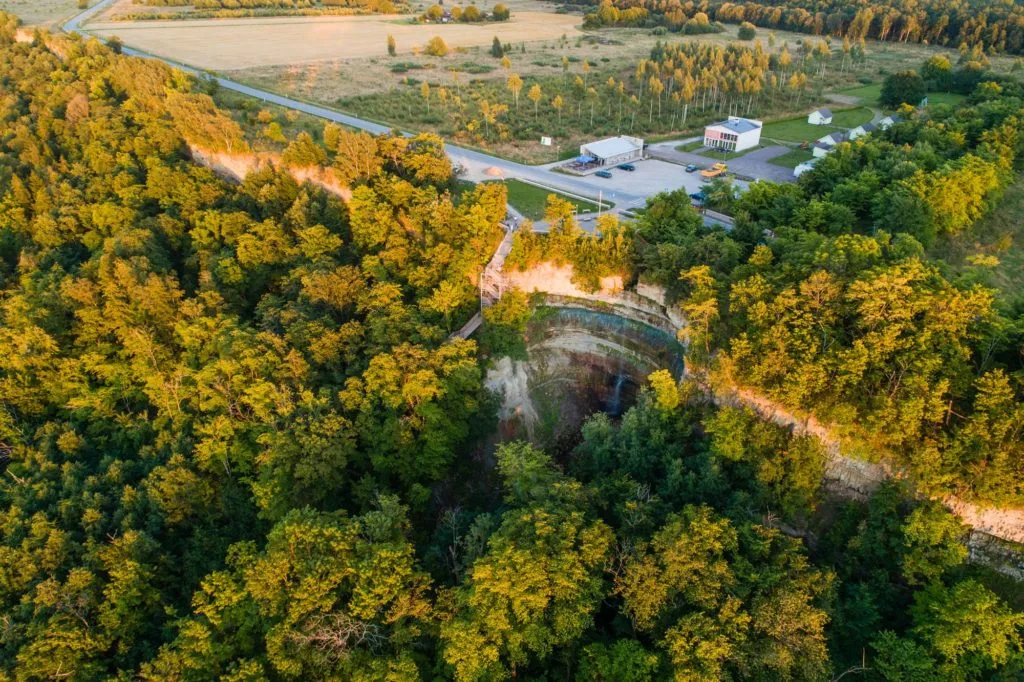Ida-Virumaa has both the highest and most powerful waterfall in Estonia, but also a range of more modest streams, which have nothing to do with the record book, but which are still worth discovering.
Unfortunately, the most powerful waterfall in Estonia, the Narva waterfall has no water and it comes to life just on few days of the year. The show is directed by a hydroelectric power plant in Russia and the schedule is not known long in advance. However, if the show appears in the play schedule in the spring, the Narva Museum will arrange for a special excursion to the territory of Kreenholm.

The waterfall disappeared in the 1950s, when the Narva River was closed with a dam above the hydroelectric power plant and water was directed to turbines. When the power plant hits the locks of its reservoir open and the spring flood waters flow into the dry bed of the Narva River, it makes the waterfalls froth proudly for a while.
Go for sure
If you have to be in the right place at the right time to enjoy the impressive performance of Narva waterfalls, then Valaste waterfall – the highest in Estonia – is more sure to show off. The water wall of about 30 meters is almost four times higher than the widest waterfall in Estonia, Jägala. Nevertheless, the new staircase and hiking trail offer a wonderful view of the layers that have formed over millions of years.

The waterfall itself can give a rather humble impression in summer, but in spring you won’t be disappointed in the spectacle. Though the best performances take place in cold weather, when the ice world opening in Valaste is admired and photographed by comers from all over Estonia.

The pride of Ida-Viru county is that six of the seven highest waterfalls in Estonia are located on this bank. This way you could spend the whole day in nature, conquering the waterfalls in order of their heights. However, if the height is not decisive and it is not a whole day for (re)exploring the waterfalls, I dare to recommend a more compact route. For example, the one that I’m used to taking in one beautiful spring day.
I select a trio from waterfalls that would be easy to find, access and observe: Kivisilla waterfall in Saka, Aluoja waterfall in Pühajõgi and Langevoja waterfall near Sillamäe.
I decide to start with Saka, because I remember from the past that there are some steep and windy stairs to struggle with. The other two waterfalls do not descend from the cliff and do not require any effort to observe. On the contrary, both Aluoja and Langevoja have excellent conditions for resting and having a picnic.
But first you have to earn your break. The discovery trip of Kivisilla waterfall starts from the territory of Saka manor, which was closed to civilians during the Soviet era due to the border guard cordon located there. The demolished manor, which was left by the border guards, has now been completely repaired and excellent conditions have been created for admiring the bank in all its genuine serenity.

There are several ways to get to the waterfall. I choose the one that should best control the fear of heights. I walk a little from the former border guard tower towards the capital and find a winding staircase descending to the sea. The curves have platforms to breathe and gobble up the beauty of the bank.
Like a stonecutter’s workshop
When you reach the beach, you feel as if you have entered the workshop of a stonecutter: some of the stones have already been polished smoothly, while others, wearing the moss hat, are waiting for the master’s hand. Should a stone artist get tired of his toil, he can entertain himself with blue clay in the meantime.
To reach the waterfall, I turn my nose towards Ontika. This time the water level favors passing the rocks and sandy beach with a dry foot. In the meantime, you have to cross the fallen tree trunks or climb under them.
Water noise indicates that you have reached your destination. The natural path leads all the way up and soon the waterfall, which falls from a height and consists of three larger terraces, appears shining in water sprays! With a drop of over 22 meters, it is second after Valaste.
Finally, it is the ’dog’s tail’ – a staircase running almost vertically to the bank of Saka – to be crossed. Fortunately, there is a handrail on the stairs that resembles a ladder, and if you keep your eyes on your feet, you can supress your fear of height and get up without calling rescuers for help.
The Aluoja waterfall on the edge of the village of Pühajõgi and near Toila Oru Park is suitable for soothing trembling legs and nerves. If you approach the waterfall from Motovilla by the motocross track, you can drive over a new wooden bridge. Wooden viewing platforms highlight the atmosphere of rural environment. The limestone-bottomed valley reveals many springs in addition to waterfalls. However, the waterfall itself has a rather changeable mind: once – very fast, next – calm and slow again.

You don’t necessarily have to drive to Aluoja waterfall. For example, for those staying at the Toila SPA hotel, there is an opportunity for a pleasant trip, which can be combined with a picnic. In order for the walk to be varied, you can go to Aluoja through the small settlement of Toila and proceed along the road of Pühajõgi manor; and return through Pühajõgi village and Toila Oru park. In total, it should make a healthy ten thousand steps.
A geographer and Ida-Viru tourism coordinator Kadri Jalonen says that Aluoja waterfall is her favorite.
„I especially liked Aluoja waterfall before it was civilized. The viewing platforms do not interfere so much, but the fact that a large part of the bush and hops was removed. In the 1990s, there was a feeling that Aluoja was the home for fairies. Going upstream, there is still a little bit left and gives an idea of what it used to be before: a completely mysterious place that has grown completely into hops. I hope the fairies still hide there in some wilder place.“
Invasion of human habitation
While Aluoja may seem civilized compared to the once savage looks, Langevoja observes a direct invasion of civilization. The location near the town of Sillamäe has left its mark. Cottages like chickens perched above the waterfall and the proximity of human settlements have ’enriched’ nature with some scattered plastic bags. Civilization also has its advantages, such as the recreation campfire built by RMK. So, you can make a longer stop at Langevoja for a break.
Next to Valaste, Langevoja is the only one of the Ida-Viru waterfalls that has been included in the book called „101 Estonian Natural Places“, published last year.
Authored by biologist and journalist, Indrek Rohtmets, it tells that in addition to the Stalinist-style stairs leading directly to the sea in the heart of the city, you can find one more staircase. „Langevoja Waterfall, which has been declared a natural monument with its cascades, is located on the territory of the settlement. Downstream, there is a steep canyon with ten-meter-high limestone walls. Cascades, waterfalls and canyons make Langevoja spring a striking sight.“
Waterfall gourmets should contact a local tour guide to find the most secret treasures to discover in nature.
Ingrid Kuligina, the head of the Alutaguse hiking club, says that she prefers little-known waterfalls, which require hiking to see. For example, Tõrvajõgi waterfall, which is difficult to find and where you have to walk a bit more. Kivisilla, Kuristiku, Martsa, Toilapiiri and Karjaoru waterfalls are also belong to those which are exciting to see namely when hiking.
SIRLE SOMMER-KALDA
„The story is written with the support of the EU Regional Development Fund“








